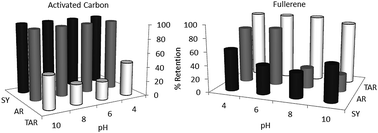Magnetic solid phase extraction based on fullerene and activated carbon adsorbents for determination of azo dyes in water samples by capillary electrophoresis
Abstract
A magnetic solid phase extraction method coupled to capillary electrophoresis for the simultaneous determination of three azo dyes (sunset yellow, allura red and tartrazine) in wastewater samples was proposed. The method employs the dispersion of magnetic adsorbents in the sample. Variables involved in the retention–elution procedures were optimized using a simplex centroid design. The optimal conditions were: an adsorbent composition of magnetite–activated carbon–fullerene (10 : 0.59 : 0.41), a sample pH of 4.0, and a sample volume (μl) : weight of adsorbent (mg) ratio of 0.01. Under optimal conditions, a linear range was obtained from 3.0–40.0 mg l−1 with limits of detection ranging from 1.0–2.0 mg l−1. The average recoveries of each dye at two spiked levels (10 and 25 mg l−1) ranged from 95–106% with relative standard deviations of less than 10% in all cases. The proposed method was applied to analyze wastewater samples from different locations. Two samples gave positive responses to the presence of tartrazine residues. The method proposed offers advantages in terms of simplicity, sensitivity, high efficiency, low cost, and short analysis time, making it an alternative for the analysis of azo dyes in water samples and other complex matrices.


 Please wait while we load your content...
Please wait while we load your content...